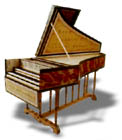by Hendrik Broekman
 Evidence for establishing pitch standards of the 18th century
indicates that there was no single standard but that most musical performance in the
baroque era took place at pitches lower than today's A-440 Hz.
Evidence for establishing pitch standards of the 18th century
indicates that there was no single standard but that most musical performance in the
baroque era took place at pitches lower than today's A-440 Hz.
Surviving harpsichords are one source from which evidence can be
adduced. When we mount wire analogous to that used by the ancients on our close copies and
pull it up only to find that it will break before it reaches modern pitch, we must think
twice about what pitch we will use as a standard. Another result of pitching a keyboard
instrument at A-440 Hz is a slight penalty in the structural longevity of the case due to
excess stress (12%) imposed by the elevated pitch. Most importantly, we now realize that
instruments sound richer and more sonorous when strung with lower tensile wire similar to
that used by 18th century builders, and when pitched at A-415 Hz or A-393 Hz, one half
tone or one whole tone below A-440 Hz.
 The transposing keyboard provides a satisfactory
compromise suited to 20th century pitch standards, the modernized instruments with which
the harpsichord must play, as well as the more severe physical environments which all
centrally heated buildings impose. The keyboard is made and installed in such a manner
that it can slide sideways to the next jack position. This permits the instrument to play
at different pitches without the need for retuning every string. The instrument is
initially set at low pitch and transposes instantly to modern pitch when needed. The true
value of the transposing keyboard is to allow the modern musician to play with other
instruments at modern pitch without compromising either the sound of the original or the
structural integrity of the instrument.
The transposing keyboard provides a satisfactory
compromise suited to 20th century pitch standards, the modernized instruments with which
the harpsichord must play, as well as the more severe physical environments which all
centrally heated buildings impose. The keyboard is made and installed in such a manner
that it can slide sideways to the next jack position. This permits the instrument to play
at different pitches without the need for retuning every string. The instrument is
initially set at low pitch and transposes instantly to modern pitch when needed. The true
value of the transposing keyboard is to allow the modern musician to play with other
instruments at modern pitch without compromising either the sound of the original or the
structural integrity of the instrument.
Most of our offerings and all of our kits are designed to be used at
A-415Hz. Transposing keyboards are provided to accommodate use at modern pitch. In cases
where the transposing keyboard would interfere with the operation of the instrument, wire
of higher tensile strength is available.